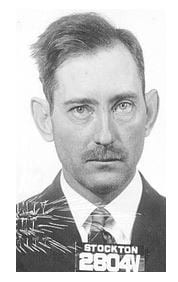
A fingerprint. We leave those everywhere, on anything we touch.
One hundred years ago, law enforcement officers learned that fingerprints could be used as a tool in fighting crime. Where was the first case that a single, latent fingerprint was used by the FBI to convict a criminal? Would you believe in rural Kansas?
The Fleagle Gang was a ruthless band of bank robbers and murderers during the 1920s. They would play a major role in the use of fingerprints in law enforcement, in a groundbreaking case in western Kansas.
The Fleagles moved from Iowa to the Garden City area in 1886. The family had two younger sons – Ralph and Jake – who liked to gamble and drink rather than work. They moved to the west coast.
Jake came back to Oklahoma, committed robbery, was arrested, fingerprinted, and jailed. When he got out, he and his older brother Ralph took up a life of crime.
They started robbing card games and then banks. After grabbing the loot, they would return to Kansas. Historians and criminal researchers estimate that they committed 60 percent of the robberies committed in California during that time, plus many robberies in Oregon, Kansas, and Colorado.

